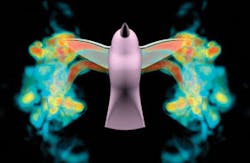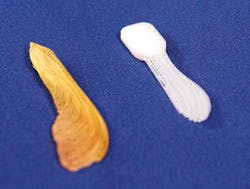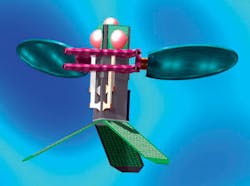By Courtney E. Howard
Engineers at myriad organizations-universities, aeronautical laboratories, research facilities, and defense contractors-are studying and emulating biological phenomena in the design and development of micro- and nanoscale unmanned aerial vehicles (UAVs).
Biomimetics or biomimicry, to paraphrase Merriam-Webster, is the study of the structure and function of biologic beings, mechanisms, substances, materials, and processes for the purpose of synthesizing artificial devices that mimic natural ones. It is not a new science, but one that is garnering increasing interest today, especially among technology firms in the defense market.
The Wright brothers, having been avid bird-watchers, are said to have modeled their airplane wing after that of a bird. Today’s innovators are likewise turning to winged species for inspiration in developing the optimal UAV for military applications.
A model MAV
The Defense Advanced Research Projects Agency’s (DARPA’s) Micro Air Vehicle (MAV) Advanced Concept Technology Demonstration (ACTD) program was begun to “further develop and integrate MAV technologies into militarily useful and affordable backpackable systems suitable for dismounted soldier, marine, and special forces missions. The MAV ACTD program is intended to get DARPA-developed small, vertical take-off and landing (VTOL) UAVs rapidly into the hands of the users.
According to DARPA’s Web site, “the FCS MAV technology is planned for transition to the Army during FY 2007.”
A major obstacle in the design of an efficient MAV, given its light weight and small size, is an efficient power source. For this and other reasons, many engineers are investigating flapping-wing entities, among them birds and insects.
AHPCRC’s modeling and simulation of hummingbird aerodynamics aided in the design of efficient flapping-wing micro-UAVs, which have a various defense applications.
The Army High Performance Computing Research Center (AHPCRC) at Network Computing Services Inc. (NCSI) in Minneapolis turned heads during the Supercomputing Conference and exhibition in Tampa, Fla., with its computer simulation of a hummingbird’s flight. The AHPCRC, a government-university-industry partnership funded by the U.S. Army and Army Research Laboratory, is committed to advancing defense technology through engineering and computational science.
Senior scientist Andrew A. Johnson and a team of engineers at AHPCRC-NCSI, with the use of Cray X1E high-performance computers from Cray Inc. in Seattle, studied slow-motion video of a hummingbird in a wind tunnel. From there, they developed a 3-D computer model of a hummingbird, as well as a detailed simulation of the bird’s wing movement, using complex computational, modeling, and simulation tools. The findings of AHPCRC’s in-depth research into hummingbird aerodynamics, including flying and hovering, was then used by the team to model a MAV design with flapping wings.
“A better understanding of the aerodynamics and performance of biological systems-birds and insects-will help us design effective micro-UAVs that can be used for defense and other applications,” Johnson says.
Similarly, Dr. Tom Richardson, a lecturer in flight mechanics at the University of Bristol, Department of Aerospace Engineering, in England, sees value in mimicking the structure and functionality of the artic tern in the design of MAVs. The artic tern, though small (as long as 15 inches with a body weight of as much as 4.59 ounces), Richardson says, can live more than 20 years and has the longest migration of any bird, at more than 12,427 miles.
Novel NAVs
DARPA’s Nano Air Vehicle (NAV) program has brought about the design and development of various unique, extremely small, and ultralightweight air-vehicle systems for military missions. To date, a majority of NAV designs are biologically inspired configurations for potential use in urban operations. One such NAV hails from engineers at Lockheed Martin Advanced Technology Laboratories based in Cherry Hill, N.J.
The DARPA NAV program goal is a vehicle that meets various requirements: it must weigh less than 10 grams, including a two-gram payload, and must be no more than 7.5 centimeters, or 3 inches, in any dimension, says Steve Jameson, NAV program manager and principle investigator at Lockheed Martin. Jameson oversees a group of 17 engineers that develops software and related technologies for autonomous unmanned systems.
The DARPA specifications also call for a mission of 20 minutes in length. “Twenty minutes is a fair amount of time, especially in a small space like an urban battlefield or civilian environment,” Jameson says. “It needs to be able to hover as well as fly up to 10 meters a second, and do a mission that is 1 kilometer out and back.” The Lockheed Martin vehicle meets all these requirements, although the design is not what DARPA executives intended.
Engineers at Lockheed Martin Advanced Technology Laboratories designed and developed a nano-UAV modeled after a maple-tree seed.
“They were looking for something that was either a flapping-wing vehicle or a miniature helicopter,” Jameson explains. “There are contractors who have proposed and are working on both of those types of vehicles. We chose something that most closely resembles a maple seed-a single-winged flyer with a wing that rotates around a hub. The wing produces lift that enables the vehicle to hover. It is powered and will offer controlled flight, as well as stable hover, during a fall from a tree. It’s a unique design for an air vehicle.”
Like a maple seed, but unlike any air vehicle that has ever been built, the entire body is rotating-a phenomena that requires finesse from structural, control, sensing, and communications points of view. In addition to controlling lift and pitch, the single wing will house telemetry, communications, navigation, imaging sensors, and battery power. The NAV will measure roughly 2 inches long and have a maximum takeoff weight of 0.35 ounces.
The rotating NAV is proving to have some interesting challenges, according to Jameson. For starters, it requires sensing technologies that enable a vehicle that is rotating very fast to sense its orientation and provide imagery to the operator controlling it from a remote-control console. The Lockheed Martin engineers found a high-speed imaging sensor to do the trick, and they are currently working on an algorithm for the image.
The single-winged NAV, although interesting as a platform for covert surveillance, given its imaging capabilities, is being designed to meet a DARPA requirement that it deliver a payload. In addition to an on-board imaging sensor and a communication link, the NAV will carry a cylinder measuring 1 centimeter by 5 millimeters and weighing 2 grams that can be swapped out from mission to mission.
“It’s not difficult at all to imagine a small vehicle that can hover safely and fly both indoors and outdoors, be controlled with a fair amount of precision, and have a stable image that can come back both outdoors and in low-light conditions being used in homeland security, first responder, police, fire, and other security situations requiring surveillance that didn’t endanger humans and was at least somewhat covert,” Jameson says.



